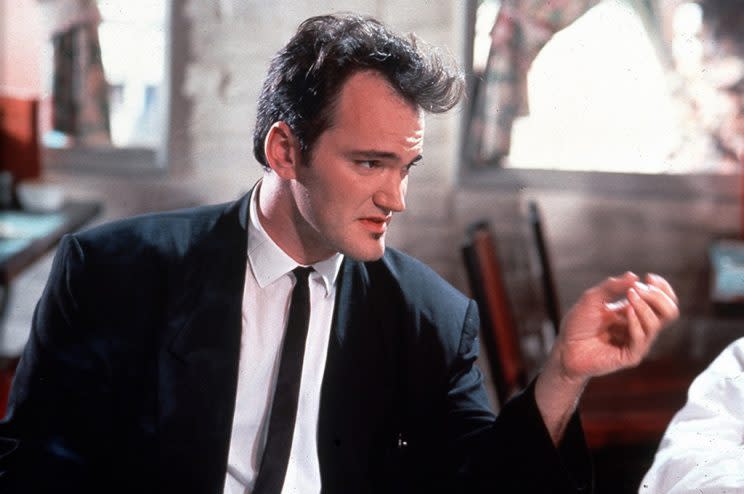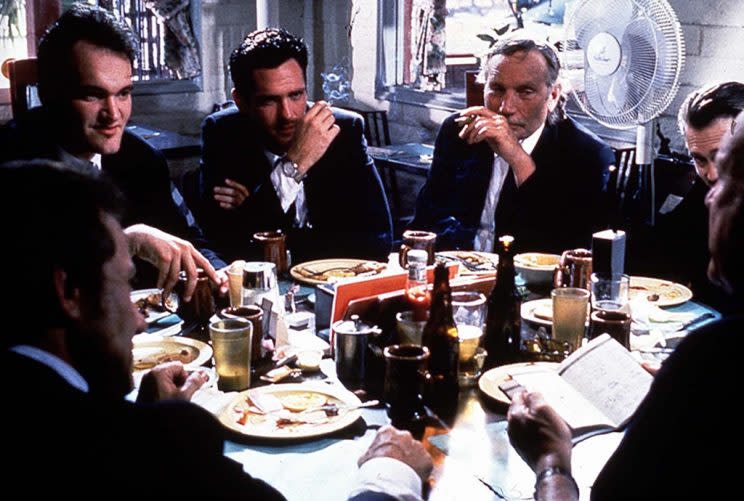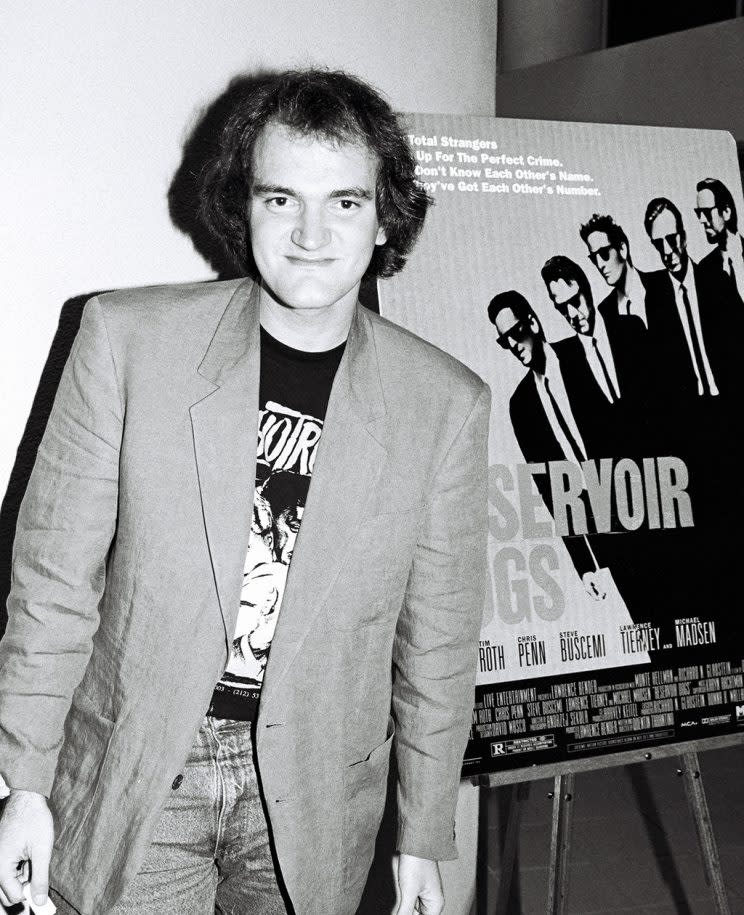'Reservoir Dogs' at 25: A Look Back at Quentin Tarantino's Bloody Sundance Debut

It’s hard to remember a time when Quentin Tarantino wasn’t the poster child for every Sundance Film Festival-bound filmmaker looking to transition from indie darling to mainstream success story. But 25 years ago in 1992, the former video store clerk arrived in Park City, Utah, as just another scrappy writer-director hoping that their debut feature would find a receptive audience and, better still, a distribution deal. That’s a story that will be repeated when the 2017 Sundance Film Festival begins this week, with hundreds of would-be Tarantinos descending on Park City looking for their own big break.
Tarantino’s contribution to Sundance’s ’92 line-up was Reservoir Dogs, a gangster vs. gangster crime picture that the official program synopsis called a “furious nuclear reaction of violence and intrigue.” That description made the low-budget crime film, produced on a tight $1.2 million budget, stand apart from that year’s other offerings, which included the festival’s usual mixture of emotional dramas like Allison Anders’s Gas Food Lodging (originally titled Gas, Food, and Lodging in its Sundance premiere) and The Waterdance and such offbeat comedies as Highway 61 and In the Soup.
Related: Red Carpet Flashback! 2002 Sundance Film Festival
Reservoir Dogs’ presence in that company wasn’t an accident. After all, Tarantino had brought his script to Park City the previous year as part of the 1991 Directors Lab, where he workshopped scenes under the tutelage of such established filmmakers as Terry Gilliam and Monte Hellman. (Footage from those sessions, which featured future Dogs cast member Steve Buscemi acting out the script, was later released on DVD and can also be found online.) So the programmers would have been aware how the movie might prove a controversial addition to the festival’s 1992 line-up, with its sequences of shootings, beatings and one very memorable ear carving.
Violence aside, though, Reservoir Dogs absolutely fit Sundance’s mission to showcase movies that defied standard conventions of American cinema. Although Tarantino’s various formal and narrative tricks — fractured timelines, long takes and rapid-fire ping pong dialogue — have long since become commonplace in his own films and in those of numerous imitators, in 1992 they were still cutting edge. Take Reservoir Dogs‘ famous opening sequence, where the eight-man heist squad tasked with stealing a batch of valuable diamonds sits around a diner table riffing on everything from the art of tipping to the real meaning of Madonna’s “Like a Virgin.” It’s clear right away that these guys — who will later turn on each other when the heist falls apart — are a breed apart, (or, if you prefer, A Band Apart) than your average Hollywood gangsters.
Watch the trailer:
In his breezy history of contemporary independent cinema, Down and Dirty Pictures, film journalist Peter Biskind describes the mixed emotions that Sundance’s staff must have felt about inviting such a bold, but also brutal, film to Park City that year:
“Festival programmers endlessly discussed whether genre films could be art films as well. Dogs nicely embodied this dilemma. It was very much a genre film, and then again it wasn’t….Violence was long regarded by Sundanistas as the special provenance of the despised Hollywood movie….People rarely died in Sundance films, lest of AIDS, old age, or boredom, and in Dogs, they not only died, they died slowly, painfully, bloodily, with feeling.”

Those concerns were borne out when Reservoir Dogs started to screen for Park City audiences. Indie film giant, John Pierson — the representative behind such era-defining films as She’s Gotta Have It and Clerks — attended the movie’s Sundance premiere and detailed his response in his 1995 book, Spike Mike Slackers & Dykes: “All of us non-Hollywood, independent types were just blown away. It had been a major concern of [festival director] Geoff Gilmore to show a film with that implied level of violence. It was a pretty earth-shattering moment.” Audiences didn’t necessarily know how to process it. In Down and Dirty Pictures, Biskind describes a forceful back-and-forth between Tarantino and a viewer at Reservoir Dogs’ last Sundance screening: “A man stood up and asked, ‘So how do you justify all the violence in this movie?’ The director replied, ‘I don’t know about you, but I love violent movies. What I find offensive is that Merchant-Ivory s—.’”
The first wave of reviews that trickled out of Sundance made a point of mentioning the violence as well. New York Times writer, Caryn James, labeled the film “a sometimes witty and frequently violent macho crime movie.” Meanwhile, Los Angeles Times critic Kenneth Turan emphasized that the movie “features more blood and violence than all the other Sundance films combined. Yet the mayhem proved to be overblown enough to take on Grand Guignol qualities, and the brash and energetic 28-year-old Tarantino, who was unapologetic at loving violence to death, clearly is a stylist to look for.”
And then there was Variety critic, Todd McCarthy, who opened his review by calling Reservoir Dogs “A show-off piece of filmmaking that will put debut writer-director Quentin Tarantino on the map.” McCarthy went on to praise the Tarantino’s “complex plot construction” and “terrific ensemble,” before delivering this parting shot: “As accomplished as all the individual elements are, however, pic feels like the director’s audition piece, an occasion for a new filmmaker to flaunt his talents. Undeniably juicy, with its salty talk and gunplay, film is nihilistic but not resonantly so, giving it no meaning outside the immediate story and characters. Pic is impressive, but impossible to love.”

Reservoir Dogs certainly received little love when the Sundance jury assembled to hand out the 1992 awards. The Grand Jury Prize went to In the Soup, while the Audience Award was bestowed upon The Waterdance. And Tarantino missed out on both directing and writing honors, with the Filmmaker Trophy going to Tony Drazan, the director of the interracial love story Zebrahead, while the Waldo Salt Screenwriting Award was handed to The Waterdance’s Neal Jimenez. Speaking to Biskind years later, Tarantino described his initial anger at being passed over for awards recognition. “It was the thing about Sundance that I hated most at the time. They were liberal in the worst sense….It hurt my feelings. I was sad, I was mad. When it was over, I did a slightly less drastic version of storming out [saying] ‘F— all you!’”

The controversy over the film’s violence, as well as the lack of awards attention, had the added impact of keeping distributors at bay in the initial weeks after Sundance. Eventually, Harvey Weinstein’s upstart company Miramax took a chance on Tarantino, birthing a partnership that turned out to be lucrative for both parties, from 1994’s Pulp Fiction through 2015’sThe Hateful Eight. Reservoir Dogs eventually opened in theaters in October 1992, and the rest is indie movie history, as Tarantino’s gift for gab — and violence — galvanized an emerging generation of film buffs and filmmakers. And if Tarantino left Park City in 1992 in frustration, he’s returning in 2017 in triumph: This year’s Sundance line-up includes a 25th anniversary screening of Reservoir Dogs followed by a Q&A with Tarantino and producer Lawrence Bender. Somewhere in the audience, the next Quentin Tarantino will likely be taking notes.
Watch Tarantino talk about ‘The Hateful Eight:’

 Yahoo Movies
Yahoo Movies 

